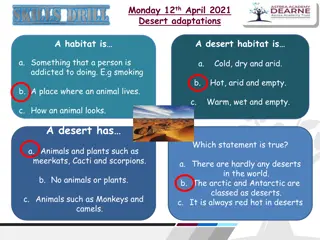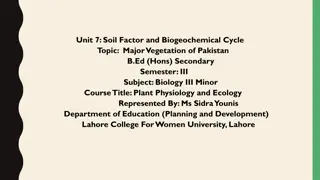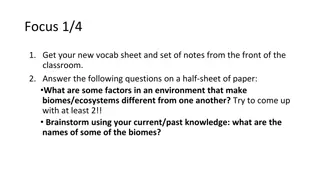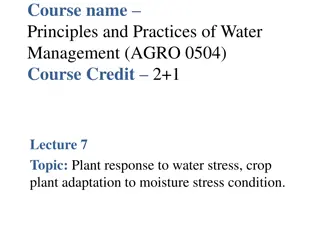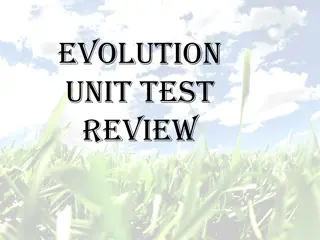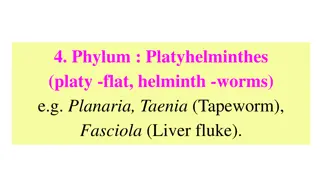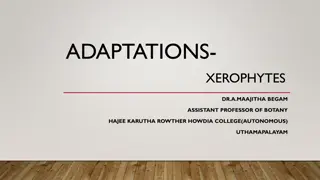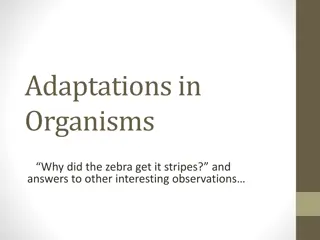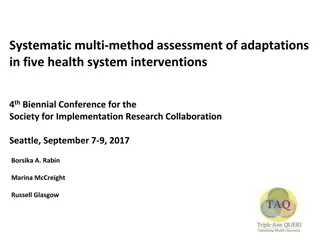Unit 1: Introduction and History of plant pathology
The science of plant pathology, which studies plant diseases and aims to protect the food supply by improving plant survival in unfavorable conditions. Explore the causes of plant diseases, their symptoms, and methods of prevention and control.
5 views • 13 slides
Amway Nutrilite All Plant Protein Powder 1kg Deutsche Post AG
Amway Nutrilite All Plant Protein Powder is a premium source of protein derived from plant-based ingredients. With each serving, you get a blend of high-quality protein to support your active lifestyle and dietary needs.\nAmway Nutrilite All Plant Protein Powder offers a convenient way to supplement
1 views • 4 slides
Evolution of Film Adaptations: From Silent Cinema to Modern Innovations
The moving picture industry emerged in the 1890s, paving the way for adaptations of literary works in the early 1900s. With the advent of sound, a new era of adaptations began, leading to experiments and innovations in modern filmmaking. Adaptation is a process of adjusting and presenting a work in
8 views • 23 slides
Birds: Adaptations of Beaks and Feet for Survival
Explore the fascinating world of bird adaptations through the modification of beaks and feet. From tearing and piercing beaks to fruit-eating beaks, mud-probing beaks, fish-catching beaks, and wood chiselling beaks, discover how different bird species have evolved unique features to thrive in their
5 views • 29 slides
Exploring Seed Plant Diversity and Adaptations
Delve into the realm of seed plants, uncovering their unique adaptations for reproduction, their phylogeny with gymnosperms and angiosperms, and the diversity within gymnosperms such as conifers, cycads, gingkophytes, and gnetophytes. Discover the evolutionary success of seed plants through their wa
5 views • 23 slides
Adaptations in Helminth Parasites: Structural and Morphological Changes
Helminth parasites exhibit adaptations for successful living within hosts, involving structural modifications such as degeneration and new organ formation. Parasitism has evolved over time, leading to a dependent relationship between parasites and hosts. The adaptations in locomotory, digestive, and
2 views • 19 slides
Desert Adaptations: Animals and Habitat Survival
Habitats play a crucial role in the survival of animals, especially in harsh environments like deserts. Explore the unique adaptations of animals like camels and learn how they are perfectly suited to thrive in hot, arid conditions. Understanding these adaptations is key to appreciating the diversit
0 views • 16 slides
Adaptations of Cursorial Animals: Cheetah, Horse, and Musk Deer
Explore the cursorial adaptations of three distinct animals - the cheetah with its incredible speed, the horse designed for swift running, and the musk deer adapted for elusive movements. Learn about their habitats, unique characteristics, and specialized adaptations for survival in their environmen
0 views • 12 slides
Major Vegetation of Pakistan - Overview and Characteristics
Vegetation in Pakistan varies from tropical forests to thorn forests, each with unique adaptations to the climate. Natural and local vegetation types like tropical dry deciduous forests and thorn forests are described, highlighting plant adaptations and environmental factors influencing growth.
0 views • 20 slides
Understanding Biomes: Climate, Vegetation, and Adaptations
Biomes are vast regions defined by climate, plant and animal communities. Factors like climate, geography, and vegetation impact the unique characteristics of each biome. Understanding biomes involves knowledge of climate, geography, vegetation adaptations, and animal diversity. Changes in one part
0 views • 23 slides
Understanding Plant Tissue Culture Media and Their Importance in In Vitro Growth
Plant tissue culture media play a crucial role in the in vitro growth and morphogenesis of plant tissues. The composition of culture media depends on the specific plant species and the type of material used for culture. Various types of media, such as White's medium, MS medium, B5 medium, N6 medium,
0 views • 6 slides
Exploring the Fascinating Tundra Biome: A Comprehensive Guide
Delve into the unique ecosystem of the tundra biome near the Arctic Circle, characterized by extreme cold, limited plant life, and diverse animal adaptations. Discover the beauty of this harsh yet resilient environment, where animals like polar bears and penguins thrive amidst challenging conditions
2 views • 11 slides
Amazing Adaptations of the Painted Turtle
Discover the incredible adaptations of the painted turtle, also known as Chrysemys picta. Surviving freezing ponds, hibernating without oxygen, and using its colorful shell for camouflage are just a few ways this unique turtle thrives in its environment. Learn how it climbs with its clawed feet and
0 views • 8 slides
Understanding Plant Pathology: Importance, Scope, and Objectives
Plant pathology, also known as phytopathology, is the study of plant diseases and their management. It covers the causes, symptoms, and impact of pathogenic organisms on plants. The field aims to understand the interactions between plants and pathogens, develop control methods, and reduce losses in
0 views • 6 slides
Introduction to Plant Physiology: Exploring the Functioning of Plants
Plant physiology is a crucial subdiscipline of botany that delves into the processes and functions operating within plants. This field closely examines areas like plant morphology, ecology, cell biology, and genetics, shedding light on vital processes such as photosynthesis, respiration, and more. T
1 views • 7 slides
Understanding Plant Anatomy and Characteristics
Explore the diverse aspects of plant life cycles, habitats, vegetative organs, stems, aerial stem modifications, leaves, phyllotaxy patterns, and leaf durations. Gain insights into the classification of roots, different types of plant habitats, and the arrangement of leaves on stems. Discover the va
2 views • 9 slides
Understanding Plant Tissue Culture: Techniques and Applications
Plant tissue culture involves maintaining and growing plant cells, tissues, or organs in artificial mediums under controlled conditions. It allows the regeneration of whole plants from small plant parts or cells. Hormones like auxins, cytokinins, and gibberellins are used in the process. Proper envi
3 views • 5 slides
Amazing Adaptations of Lions in the Wild
Lions have incredible adaptations that aid in their survival and hunting strategies. Their loose body skin, mane, eyes, muscled forelimbs, rough tongue, color, and more play crucial roles in their ability to thrive in their environment. Explore these fascinating adaptations through images and descri
0 views • 8 slides
Understanding Habitats, Adaptations, and Food Chains in Ecosystems
Explore the concepts of habitats, adaptations, and food chains in ecosystems. Learn how different environments support diverse organisms, how adaptations aid survival, the impact of competition for resources, and the flow of matter and energy through food chains. Discover the interdependence of plan
0 views • 51 slides
Plant Tissue Culture Methods for Growth and Reproduction Study
Plant tissue culture methods such as root tip culture, shoot-tip culture, leaf culture, flower culture, and anther and pollen culture allow for the study of growth, reproduction, and genetic variations in plants. These techniques involve culturing various plant parts under sterile conditions to inve
1 views • 20 slides
Understanding Plant Quarantine and Phytosanitary Measures
Plant quarantine involves efforts to prevent the entry, establishment, or spread of foreign pests through legal restrictions on plant and plant product movement. It is crucial for safeguarding plant health, food production, and ecosystems. Phytosanitary measures aim to ensure the health of plants by
0 views • 33 slides
Understanding Mineral Nutrition in Plants
Mineral nutrition in plants involves the acquisition of essential elements in the form of inorganic ions from soil, followed by their absorption and utilization in various plant processes. Around 60 different elements have been reported in plants, with 30 being essential for plant growth. These esse
0 views • 39 slides
Plant Responses to Water Stress in Agricultural Management
Understanding how plants respond to water stress is crucial for effective agricultural management. Stress can affect plant growth and development, leading to various adaptations such as resistance, avoidance, and tolerance. This course explores the physiological mechanisms behind plant stress respon
0 views • 44 slides
Plant Propagation Techniques in Nursery Environment
Learn about plant propagation techniques within a nursery environment, including nursery operations, potting seedlings, plant protection, weed control, packing of nursery plants, and crafting tissues for plant growth. Explore the essential tasks involved in nurturing seedlings and trees before they
0 views • 17 slides
Evolution Unit Test Review - Adaptations and Benefits Matching
In this review, you will match various adaptations to the benefits they provide in the context of evolution. From heavy fur of the Snow Leopard to wing-like shape of maple seeds, explore how different adaptations help organisms cope with climate, obtain food and water, attract mates, escape predator
0 views • 21 slides
Plant Health Initiatives at the 27th Technical Consultation Among Regional Plant Protection Organizations - Memphis, Tennessee
The 27th Technical Consultation in Memphis, Tennessee focused on plant health initiatives by the International Regional Organization for Plant and Animal Health. OIRSA emphasized four key technical areas: plant health, animal health, agricultural quarantine, and food safety. Projects included addres
0 views • 13 slides
Amazing Adaptations of Giraffes
Giraffes have unique adaptations that help them thrive in their environment. With their long necks, tough hooves, and specialized features like long tongues and tough lips, giraffes can reach high branches, protect themselves from harm, and access water efficiently. These adaptations, such as their
0 views • 10 slides
Plant Growth Hormones and Defense Mechanisms: Understanding Plant Responses to the Environment
Plant growth hormones and defense mechanisms play crucial roles in how plants respond to environmental stimuli such as water, sunlight, gravity, and more. From auxins promoting cell growth to gibberellins stimulating flowering, this presentation educates on the intricacies of plant hormones and thei
1 views • 13 slides
Understanding Plant Hormones and Their Role in Growth and Development
Plant hormones are vital compounds that regulate various processes in plant growth and development. They are mostly organic and can be gases. These hormones are produced in one part of the plant and transported to other parts where they induce physiological effects. The main phytohormones include Au
0 views • 125 slides
Adaptations of Xerophytes in Different Habitats
Xerophytes, plants adapted to dry habitats, possess specific adaptations to prevent excessive water loss such as sunken stomata, presence of hairs, thick waxy cuticle, and rolled leaves. These adaptations help xerophytes thrive in arid conditions, maintaining humid air around stomata and maximizing
0 views • 13 slides
Tiger Adaptations and Characteristics
Tigers possess unique adaptations such as their striped coat for camouflage, sensitive hearing capable of picking up infrasound, retinas that reflect more light, sharp claws for hunting and climbing, large teeth for catching prey, a long tail for balance while running, and a powerful roar when threa
0 views • 9 slides
Animal Adaptations in Different Habitats
Understanding animal adaptations in various habitats is crucial for appreciating how different species have evolved to thrive in specific environmental conditions. This presentation explores different habitats like woodlands, sand dunes, and rock pools, highlighting the unique features and adaptatio
0 views • 11 slides
Understanding Platyhelminthes: Characteristics and Adaptations
Platyhelminthes, also known as flatworms, exhibit a dorsoventrally flattened body with bilateral symmetry. They can be endoparasites or free-living organisms, with some displaying unique adaptations for attachment and survival. These acoelomate organisms lack a complete digestive system, excreting w
0 views • 6 slides
Exploring Crayfish Anatomy and Adaptations in Biology Lab
Explore the fascinating world of crayfish anatomy and adaptations through hands-on dissection activities in a biology lab setting. Identify phylum, examine external anatomy, study compound eyes, and delve into the function-form relationship within the phylum. Engage in interactive tasks like drawing
0 views • 22 slides
Exploring the Fundamentals of Plant Pathology: Understanding Viruses in Plant Diseases
Delve into the world of plant pathology with Mr. Vikash Kumar, as you learn about the nature, structure, and transmission of viruses affecting plants. Explore the important characteristics of plant viruses, their unique properties, and how they interact within plant cells. Gain insights into viral d
0 views • 14 slides
Xerophytes: Adaptations to Thrive in Dry Environments
Xerophytes are plants that adapt to dry habitats by developing specialized structural and physiological features. These adaptations include deep root systems, succulent tissues for water storage, reduced leaf size with protective waxy coatings, and shortened life cycles for favorable conditions. Mor
0 views • 8 slides
Understanding Adaptations in Organisms: from Zebra Stripes to Diabetes
Adaptations in organisms play a crucial role in survival within their ecological niche. This article explores the reasons behind zebra stripes, the impact of traits that may not seem advantageous, the mechanisms of diabetes, and how environmental conditions can influence genetic traits. By delving i
0 views • 20 slides
Overview of Plant Quarantine and Disease Management
Plant quarantine is a crucial practice that involves regulating the movement of plants and plant products to prevent the spread of pests and diseases. Originating with the first law in France in 1860, plant quarantine now encompasses various methods such as embargoes and inspections to safeguard pla
0 views • 11 slides
Aquatic Adaptations in Marine Life
This informative content discusses the primary and secondary aquatic adaptations in marine animals such as fish, whales, turtles, and ducks. It covers various adaptations like streamlined bodies, presence of swim bladders, flippers for navigation, and webbed feet for swimming. Each adaptation is vit
1 views • 14 slides
Systematic Assessment of Adaptations in Health System Interventions
This presentation at the 4th Biennial Conference for the Society for Implementation Research Collaboration discusses the systematic multi-method assessment of adaptations in five health system interventions. It covers the definitions of adaptations, balancing fidelity and adaptation, and lessons lea
0 views • 23 slides






